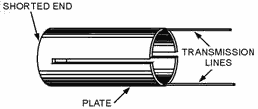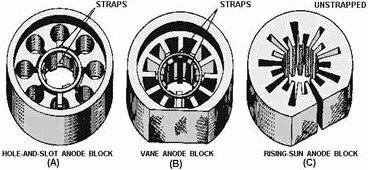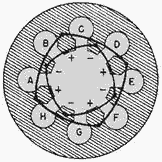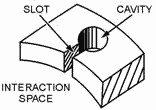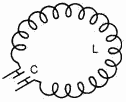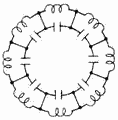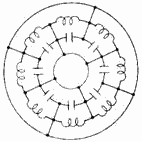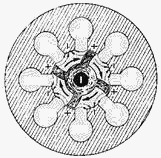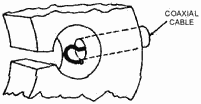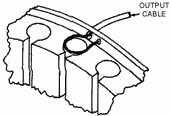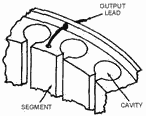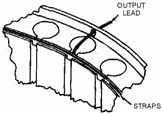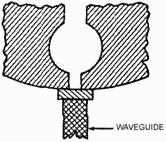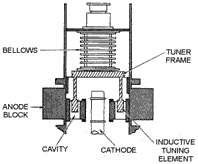Module 11 - Microwave Principles |
||||||||||||||||||||||||||||||||||||||||||||||||||
|
Module 11 − Microwave Principles
Pages i, 1−1, 1−11, 1−21, 1−31, 1−41, 1−51, 1−61, 2−1, 2−11, 2−21, 2−31, 2−41, 2−51, 2−61, 3−1, 3−11, AI−1, Index−1, Assignment 1, Assignment 2
The output of a magnetron is reduced by the bombardment of the filament by electrons which travel in loops, shown in figure 2-22, views (B) and (C). This action causes an increase of filament temperature under conditions of a strong magnetic field and high plate voltage and sometimes results in unstable operation of the tube. The effects of filament bombardment can be reduced by operating the filament at a reduced voltage. In some cases, the plate voltage and field strength are also reduced to prevent destructive filament bombardment.
ELECTRON-RESONANCE MAGNETRON. - In the electron-resonance magnetron, the plate is constructed to resonate and function as a tank circuit. Thus, the magnetron has no external tuned circuits. Power is delivered directly from the tube through transmission lines, as shown in figure 2-25. The constants and operating conditions of the tube are such that the electron paths are somewhat different from those in figure 2-24. Instead of closed spirals or loops, the path is a curve having a series of sharp points, as illustrated in figure 2-26. Ordinarily, this type of magnetron has more than two segments in the plate. For example, figure 2-26 illustrates an eight-segment plate.
Figure 2-25. - Plate tank circuit of a magnetron.
Figure 2-26. - Electron path in an electron-resonance magnetron.
The electron-resonance magnetron is the most widely used for microwave frequencies because it has reasonably high efficiency and relatively high output. The average power of the electron-resonance magnetron is limited by the amount of cathode emission, and the peak power is limited by the maximum voltage rating of the tube components. Three common types of anode blocks used in electron-resonance magnetrons are shown in figure 2-27.
2-31
Figure 2-27. - Common types of anode blocks.
The anode block shown in figure 2-27, view (A), has cylindrical cavities and is called a HOLE- and-SLOT ANODE. The anode block in view (B) is called the VANE ANODE which has trapezoidal cavities. The first two anode blocks operate in such a way that alternate segments must be connected, or strapped, so that each segment is opposite in polarity to the segment on either side, as shown in figure 2- 28. This also requires an even number of cavities.
Figure 2-28. - Strapping alternate segments.
The anode block illustrated in figure 2-27, view (C), is called a RIsING-SUN Block. The alternate large and small trapezoidal cavities in this block result in a stable frequency between the resonant frequencies of the large and small cavities. Figure 2-29A, shows the physical relationships of the resonant cavities contained in the hole-and-slot anode (figure 2-27, view (A)). This will be used when analyzing the operation of the electron-resonance magnetron. 2-32
Figure 2-29A. - Equivalent circuit of a hole-and-slot cavity.
Figure 2-29B. - Equivalent circuit of a hole-and-slot cavity.
Electrical Equivalent. - Notice in figure 2-29A, that the cavity consists of a cylindrical hole in the copper anode and a slot which connects the cavity to the interaction space. The equivalent electrical circuit of the hole and slot is shown in figure 2-29B. The parallel sides of the slot form the plates of a capacitor while the walls of the hole act as an inductor. The hole and slot thus form a high-Q, resonant LC circuit. As shown in figure 2-27, the anode of a magnetron has a number of these cavities. An analysis of the anodes in the hole-and-slot block reveals that the LC tanks of each cavity are in series (assuming the straps have been removed), as shown in figure 2-30. However, an analysis of the anode block after alternate segments have been strapped reveals that the cavities are connected in parallel because of the strapping. Figure 2-31 shows the equivalent circuit of a strapped anode.
Figure 2-30. - Cavities connected in series.
2-33
Figure 2-31. - Cavities in parallel because of strapping.
Electric Field. - The electric field in the electron-resonance oscillator is a product of ac and dc fields. The dc field extends radially from adjacent anode segments to the cathode, as shown in figure 2- 32. The ac fields, extending between adjacent segments, are shown at an instant of maximum magnitude of one alternation of the RF oscillations occurring in the cavities.
Figure 2-32. - Probable electron paths in an electron-resonance magnetron oscillator.
The strong dc field going from anode to cathode is created by a large, negative dc voltage pulse applied to the cathode. This strong dc field causes electrons to accelerate toward the plate after they have been emitted from the cathode. Recall that an electron moving against an E field is accelerated by the field and takes energy from the field. Also, an electron gives up energy to a field and slows down if it is moving in the same direction as the field (positive to negative). Oscillations are sustained in a magnetron because as electrons pass through the ac and dc fields, they gain energy from the dc field and give up energy to the ac field. The electrons that give up energy to the ac field are called Working ELECTRONS. However, not all of the electrons give up energy to the ac field. Some electrons take energy from the ac field, which is an undesirable action. In figure 2-32, consider electron Q1, which is shown entering the field around the slot entrance to cavity A. The clockwise rotation of the electron path is caused by the interaction of the magnetic field around the moving electron with the permanent magnetic field. The permanent magnetic field is assumed to be going into the paper in figure 2-32 (the action of an electron moving in an H field was explained
2-34 earlier). Notice that electron Q1 is moving against the ac field around cavity A. The electron takes energy from the ac field and then accelerates, turning more sharply when its velocity increases. Thus, electron Q1 turns back toward the cathode. When it strikes the cathode, it gives up the energy it received from the ac field. This bombardment also forces more electrons to leave the cathode and accelerate toward the anode. Electron Q2 is slowed down by the field around cavity B and gives up some of its energy to the ac field. Since electron Q2 loses velocity, the deflective force exerted by the H field is reduced. The electron path then deviates to the left in the direction of the anode, rather than returning to the cathode as did electron Q1. The cathode to anode potential and the magnetic field strength determine the amount of time for electron Q2 to travel from a position in front of cavity B to a position in front of cavity C. Cavity C is equal to approximately 1/2 cycle of the RF oscillations of the cavities. When electron Q2 reaches a position in front of cavity C, the ac field of cavity C is reversed from that shown. Therefore, electron Q2 gives up energy to the ac field of cavity C and slows down even more. Electron Q2 actually gives up energy to each cavity as it passes and eventually reaches the anode when its energy is expended. Thus, electron Q2 has helped sustain oscillations because it has taken energy from the dc field and given it to the ac field. Electron Q1, which took energy from the ac field around cavity A, did little harm because it immediately returned to the cathode. The cumulative action of many electrons returning to the cathode while others are moving toward the anode forms a pattern resembling the moving spokes of a wheel known as a SPACE-CHARGE WHEEL, as indicated in figure 2-33. Electrons in the spokes of the wheel are the working electrons. The space-charge wheel rotates about the cathode at an angular velocity of 2 poles (anode segments) per cycle of the ac field. This phase relationship enables the concentration of electrons to continuously deliver energy to sustain the RF oscillations. Electrons emitted from the area of the cathode between the spokes are quickly returned to the cathode. In figure 2-33 the alternate segments between cavities are assumed to be at the same potential at the same instant. An ac field is assumed to exist across each individual cavity. This mode of operation is called the PI Mode, since adjacent segments of the anode have a phase difference of 180 degrees, or one-pi radian. Several other modes of oscillation are possible, but a magnetron operating in the pi mode has greater power and output and is the most commonly used.
Figure 2-33. - Rotating space-charge wheel in an eight-cavity magnetron. 2-35 An even number of cavities, usually six or eight, are used and alternate segments are strapped to ensure that they have identical polarities. The frequency of the pi mode is separated from the frequency of the other modes by strapping. For the pi mode, all parts of each strapping ring are at the same potential; but the two rings have alternately opposing potentials, as shown in figure 2-34. Stray capacitance between the rings adds capacitive loading to the resonant mode. For other modes, however, a phase difference exists between the successive segments connected to a given strapping ring which causes current to flow in the straps.
Figure 2-34. - Alternate segments connected by strapping rings.
The straps contain inductance, and an inductive shunt is placed in parallel with the equivalent circuit. This lowers the inductance and increases the frequency at modes other than the pi mode.
Q-38. What is the primary difference in construction between the basic magnetron and the negative- resistance magnetron?
Q-39. What starts the oscillations in a negative-resistance magnetron?
Q-40. Why is the negative-resistance magnetron often operated with reduced filament voltage? Q-41. What type of electron-resonance anode block does not require strapping?
Q-42. Without strapping, the resonant cavities of a hole-and-slot anode are connected in what manner?
Q-43. What are the electrons called that give up energy to the ac field in a magnetron?
Coupling Methods. - Energy (RF) can be removed from a magnetron by means of a Coupling Loop. At frequencies lower than 10,000 megahertz, the coupling loop is made by bending the inner conductor of a coaxial cable into a loop. The loop is then soldered to the end of the outer conductor so that it projects into the cavity, as shown in figure 2-35A. Locating the loop at the end of the cavity, as shown in figure 2-35B, causes the magnetron to obtain sufficient pickup at higher frequencies. 2-36
Figure 2-35A. - Magnetron coupling methods.
Figure 2-35B. - Magnetron coupling methods.
The SEGMENT-FED Loop METHOD is shown in figure 2-35C. The loop intercepts the magnetic lines passing between cavities. The STRAP-FED Loop METHOD (figure 2-35D), intercepts the energy between the strap and the segment. On the output side, the coaxial line feeds another coaxial line directly or feeds a waveguide through a choke joint. The vacuum seal at the inner conductor helps to support the line. APERTURE, OR SLOT, Coupling is illustrated in figure 2-35E. Energy is coupled directly to a waveguide through an iris.
Figure 2-35C. - Magnetron coupling methods.
2-37
Figure 2-35D. - Magnetron coupling methods.
Figure 2-35E. - Magnetron coupling methods.
MAGNETRON TUNING. - a tunable magnetron permits the system to be operated at a precise frequency anywhere within a band of frequencies, as determined by magnetron characteristics. The resonant frequency of a magnetron may be changed by varying the inductance or capacitance of the resonant cavities. In figure 2-36, an inductive tuning element is inserted into the hole portion of the hole-and-slot cavities. It changes the inductance of the resonant circuits by altering the ratio of surface area to cavity volume in a high-current region. The type of tuner illustrated in figure 2-36 is called a SPROCKET TUNER or CROWN-of-THORNS TUNER. All of its tuning elements are attached to a frame which is positioned by a flexible bellows arrangement. The insertion of the tuning elements into each anode hole decreases the inductance of the cavity and therefore increases the resonant frequency. One of the limitations of inductive tuning is that it lowers the unloaded Q of the cavities and therefore reduces the efficiency of the tube. 2-38
Figure 2-36. - Inductive magnetron tuning.
The insertion of an element (ring) into the cavity slot, as shown in figure 2-37, increases the slot capacitance and decreases the resonant frequency. Because the gap is narrowed in width, the breakdown voltage is lowered. Therefore, capacitively tuned magnetrons must be operated with low voltages and at low-power outputs. The type of capacitive tuner illustrated in figure 2-37 is called a COOKIE-CUTTER TUNER. It consists of a metal ring inserted between the two rings of a double-strapped magnetron, which serves to increase the strap capacitance. Because of the mechanical and voltage breakdown problems associated with the cookie-cutter tuner, it is more suitable for use at longer wavelengths. Both the capacitance and inductance tuners described are symmetrical; that is, each cavity is affected in the same manner, and the pi mode is preserved.
Figure 2-37. - Capacitive magnetron tuning. 2-39 A 10-percent frequency range may be obtained with either of the two tuning methods described above. Also, the two tuning methods may be used in combination to cover a larger tuning range than is possible with either one alone. ARCING IN MAGNETRONS. - During initial operation a high-powered magnetron arcs from cathode to plate and must be properly BROKEN IN or BAKED IN. Actually, arcing in magnetrons is very common. It occurs with a new tube or following long periods of idleness. One of the prime causes of arcing is the release of gas from tube elements during idle periods. Arcing may also be caused by the presence of sharp surfaces within the tube, mode shifting, and by drawing excessive current. While the cathode can withstand considerable arcing for short periods of time, continued arcing will shorten the life of the magnetron and may destroy it entirely. Therefore, each time excessive arcing occurs, the tube must be baked in again until the arcing ceases and the tube is stabilized. The baking-in procedure is relatively simple. Magnetron voltage is raised from a low value until arcing occurs several times a second. The voltage is left at that value until arcing dies out. Then the voltage is raised further until arcing again occurs and is left at that value until the arcing again ceases. Whenever the arcing becomes very violent and resembles a continuous arc, the applied voltage is excessive and should be reduced to permit the magnetron to recover. When normal rated voltage is reached and the magnetron remains stable at the rated current, the baking-in is complete. a good maintenance practice is to bake-in magnetrons left idle in the equipment or those used as spares when long periods of nonoperating time have accumulated. The preceding information is general in nature. The recommended times and procedures in the technical manuals for the equipment should be followed when baking-in a specific type magnetron.
The Crossed-Field Amplifier (Amplitron) The CROSSED-FIELD Amplifier (CFA), commonly known as an AMPLITRON and sometimes referred to as a PLATINOTRON, is a broadband microwave amplifier that can also be used as an oscillator. The cfa is similar in operation to the magnetron and is capable of providing relatively large amounts of power with high efficiency. The bandwidth of the CFA, at any given instant, is approximately plus or minus 5 percent of the rated center frequency. Any incoming signals within this bandwidth are amplified. Peak power levels of many megawatts and average power levels of tens of kilowatts average are, with efficiency ratings in excess of 70 percent, possible with crossed-field amplifiers. Because of the desirable characteristics of wide bandwidth, high efficiency, and the ability to handle large amounts of power, the CFA is used in many applications in microwave electronic systems. This high efficiency has made the CFA useful for space-telemetry applications, and the high power and stability have made it useful in high-energy, linear atomic accelerators. When used as the intermediate or final stage in high-power radar systems, all of the advantages of the CFA are used. Since the CFA operates in a manner so similar to the magnetron, the detailed theory is not presented in this module. Detailed information of CFA operation is available in NAVSHIPS 0967-443-2230, Handling, Installation and Operation of Crossed-Field Amplifiers. As mentioned earlier, crossed-field amplifiers are commonly called Amplitrons. You should note, however, that Amplitron is a trademark of the Raytheon Manufacturing Company for the Raytheon line of crossed-field amplifiers. An illustration of a crossed- field amplifier is shown in figure 2-38. 2-40
|
||||||||||||||||||||||||||||||||||||||||||||||||||
